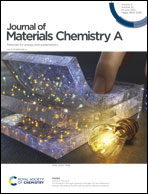A dopant-free donor–acceptor type semi-crystalline polymeric hole transporting material for superdurable perovskite solar cells†
Abstract
In this work, the performance of perovskite solar cell (PSC) devices using semi-crystalline polymers (PNTDT-TT, PNTDT-2T, and PNTDT-2F2T) consisting of bis-lactam 1,5-dioctyl-3,7-di(thiophen-2-yl)-1,5-naphthyridine-2,6-dione (NTDT) and different donating units depends on the crystalline nature of the polymer. The N-alkylated NTDT unit endows the final polymer with appropriate solubility without backbone distortion. Therefore, despite having strong intra- and inter-molecular interactions of PNTDT-2F2T, it can be easily processed and show much better film formability at moderate solution temperature compared with typical semi-crystalline polymers. Using fully dopant-free PNTDT-2F2T enables PSCs to achieve very high power conversion efficiencies (PCE) of 20.6% and 22.19% in MAPbI3- and Cs0.05FA0.90MA0.05PbI2.85Br0.15-based perovskites, respectively, owing to the large crystal coherence length and excellent hole mobility. The device retains nearly 90% of its initial PCE after storage at a relative humidity of ∼90% for 1560 h. The PNTDT-2F2T-based PSCs show consistent performance even after soaking in water because of the dense packing and superior hydrophobicity of the PNTDT-2F2T film. Also, owing to the superior thermal stability, the PSC devices with PNTDT-2F2T retain over 85% of their initial efficiency after continuous thermal aging (80 °C) for 1008 h, whereas spiro-OMeTAD-based PSC devices exhibit irreversible severe degradation.



 Please wait while we load your content...
Please wait while we load your content...